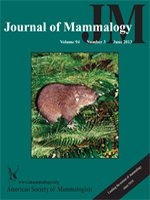Habitat specialization is considered one of the most important determinants of species vulnerability to habitat loss and fragmentation because it defines species dispersal ability and thus the degree of isolation of populations. Further, dispersal success of habitat-specialist species depends on the distance between fragments, which is conditioned on the total amount of habitat in the landscape. Here, we compared the influence of total habitat amount on dispersal success and abundance patterns of 2 habitat specialists and 1 generalist Atlantic Forest rodent. We investigated short-term population dynamics in a continuous forest landscape as well as in 6 small forest fragments located in 2 landscapes differing in the amount of forest cover (30% and 50%). Further, we analyzed the influence of fragment size on population density in the fragmented landscapes. Number of immigrants and abundance of both habitat-specialist species decreased remarkably in small patches of the 30% forest cover landscape compared to both more-forested landscapes, and both species showed a patch-area effect on density in this landscape. In contrast, the generalist species showed similar immigration rates in continuous forest and patches of the less-forested landscape, high temporal and spatial variability in abundance, and no patch-area effect in any of the landscapes. The results provide empirical support for the interaction between habitat specialization and habitat amount in determining the response of species to habitat loss, showing that the response of habitat specialists—in contrast to generalists—is governed by the landscape-wide amount of habitat.
Especialização de habitat é considerada uma dos mais importantes determinantes da vulnerabilidade das espécies à perda de habitat e fragmentação uma vez que define a capacidade de dispersão e consequentemente o grau de isolamento das populações. Além disso, a dispersão bem-sucedida de espécies especialistas de habitat depende da distância entre fragmentos, a qual é condicionada pela quantidade total de habitat na paisagem. Neste estudo comparamos a influencia da quantidade total de habitat no sucesso de dispersão e padrões de abundância de 2 espécies especialistas de habitat e 1 generalista de roedores da Mata Atlântica. Nós investigamos a dinâmica populacional em um estudo de curta duração em uma paisagem florestal contínua assim como em 6 pequenos fragmentos florestais localizados em paisagens que diferiam quanto à quantidade de cobertura florestal (30% e 50%). Adicionalmente, nós analisamos a influência do tamanho do fragmento na densidade populacional em paisagens fragmentadas. O número de imigrantes e abundância de ambas as espécies especialistas de habitat diminuíram consideravelmente em pequenos fragmentos da paisagem com 30% de cobertura florestal comparados com ambas as paisagens com maior cobertura florestal e ambas as espécies apresentaram um efeito patch-area em suas densidades nesta paisagem. Ao contrário, a espécie generalista apresentou taxas de imigração similares em florestas e fragmentos da paisagem com menor cobertura florestal, alta variabilidade temporal e espacial na abundância e nenhum efeito patch-area em nenhuma das paisagens. Os resultados fornecem apoio empírico para a interação entre a especialização de habitat e a quantidade de habitat na determinação da resposta das espécies à perda de habitat, mostrando que a resposta dos especialistas de habitat—ao contrário dos generalistas—é regulada pela quantidade de habitat numa escala mais ampla da paisagem.





